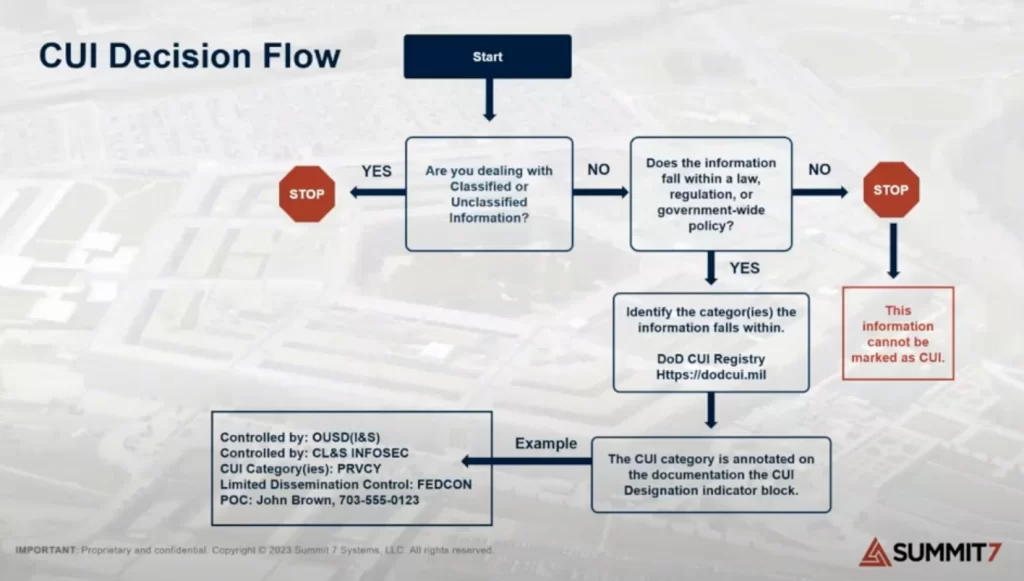What is CUI Basic?
CUI Basic is a simplified version of the Controlled Unclassified Information (CUI) program, which is a federal government-wide initiative to standardize the way executive branch agencies handle sensitive information that is not classified. CUI Basic is designed to provide a less complex and more streamlined approach to handling unclassified information that requires safeguarding or dissemination controls, particularly for state, local, tribal, and private sector entities that may not have the resources or expertise to fully implement the CUI program.
Understanding CUI Basic
The CUI Basic category is one of the two main categories of the CUI program, the other being CUI Specified. CUI Basic applies to unclassified information that requires safeguarding or dissemination controls based on laws, regulations, or government-wide policies, but is not subject to specific requirements in a CUI Specified category. In other words, CUI Basic serves as a catch-all for information that needs to be protected but does not fit into a more specific CUI category.The CUI Basic requirements are less stringent than those for CUI Specified categories, which have additional requirements based on the specific laws, regulations, or government-wide policies that apply to that type of information. CUI Basic allows for more flexibility in implementation, while still providing a consistent set of safeguarding and dissemination controls to protect the information.
Key Characteristics of CUI Basic
- Applicability: CUI Basic applies to unclassified information that requires safeguarding or dissemination controls but is not subject to specific requirements in a CUI Specified category.
- Safeguarding Requirements: CUI Basic has a set of baseline safeguarding requirements that must be implemented to protect the information, such as access controls, physical security measures, and cybersecurity controls.
- Dissemination Controls: CUI Basic has a set of dissemination controls that must be followed when sharing the information with others, such as marking the information as CUI and obtaining authorization before disseminating it.
- Flexibility: CUI Basic allows for more flexibility in implementation compared to CUI Specified categories, as it does not have additional requirements based on specific laws, regulations, or government-wide policies.
- Applicability to Non-Federal Entities: CUI Basic is particularly relevant for state, local, tribal, and private sector entities that may not have the resources or expertise to fully implement the CUI program, as it provides a simplified approach to handling unclassified information that requires protection.
Implementation of CUI Basic
The implementation of CUI Basic involves several key steps:
- Identification: Identifying information that falls under the CUI Basic category based on the definition and characteristics of CUI Basic.
- Safeguarding: Implementing the baseline safeguarding requirements for CUI Basic to protect the information from unauthorized access, disclosure, or modification.
- Dissemination: Following the dissemination controls for CUI Basic when sharing the information with others, such as marking the information as CUI and obtaining authorization before disseminating it.
- Training: Providing training to personnel who handle CUI Basic information on the requirements and procedures for safeguarding and disseminating the information.
- Oversight: Establishing oversight mechanisms to ensure compliance with CUI Basic requirements and to monitor and address any incidents or breaches related to CUI Basic information.
Benefits of CUI Basic
- Standardization: CUI Basic provides a standardized approach to handling unclassified information that requires safeguarding or dissemination controls, which helps to ensure consistency across different agencies and entities.
- Simplified Implementation: CUI Basic is designed to be less complex and more streamlined compared to the full CUI program, making it easier for state, local, tribal, and private sector entities to implement.
- Improved Information Sharing: By providing a consistent set of safeguarding and dissemination controls for CUI Basic information, CUI Basic facilitates the sharing of information between different agencies and entities while still protecting the information from unauthorized access or disclosure.
- Enhanced Security: CUI Basic helps to enhance the security of unclassified information that requires protection by providing a baseline set of safeguarding requirements and dissemination controls.
- Compliance with Legal Requirements: CUI Basic helps entities to comply with legal requirements related to the handling of sensitive unclassified information, such as the Federal Information Security Modernization Act (FISMA) and the Privacy Act of 1974.
FAQ Section
Q: What is the difference between CUI Basic and CUI Specified?
A: CUI Basic applies to unclassified information that requires safeguarding or dissemination controls but is not subject to specific requirements in a CUI Specified category. CUI Specified has additional requirements based on the specific laws, regulations, or government-wide policies that apply to that type of information.
Q: Who is responsible for implementing CUI Basic?
A: Executive branch agencies are responsible for implementing CUI Basic within their organizations. State, local, tribal, and private sector entities that handle CUI Basic information are also responsible for implementing the CUI Basic requirements.
Q: What are the safeguarding requirements for CUI Basic?
A: CUI Basic has a set of baseline safeguarding requirements that must be implemented to protect the information, such as access controls, physical security measures, and cybersecurity controls. The specific requirements are outlined in the CUI Basic guidance and standards.
Q: Can CUI Basic information be shared with the public?
A: CUI Basic information can only be shared with the public if it is determined to be releasable under the Freedom of Information Act (FOIA) or other applicable laws and regulations. Dissemination controls must be followed when sharing CUI Basic information, such as marking the information as CUI and obtaining authorization before disseminating it.
Q: What happens if CUI Basic requirements are not followed?
A: Failure to follow CUI Basic requirements can result in unauthorized access, disclosure, or modification of sensitive information, which can have serious consequences for the individuals or entities involved. Agencies and entities that handle CUI Basic information are responsible for establishing oversight mechanisms to ensure compliance with CUI Basic requirements and to monitor and address any incidents or breaches related to CUI Basic information.
Summary Table
| Characteristic | Description |
|---|---|
| Applicability | CUI Basic applies to unclassified information that requires safeguarding or dissemination controls but is not subject to specific requirements in a CUI Specified category. |
| Safeguarding Requirements | CUI Basic has a set of baseline safeguarding requirements that must be implemented to protect the information, such as access controls, physical security measures, and cybersecurity controls. |
| Dissemination Controls | CUI Basic has a set of dissemination controls that must be followed when sharing the information with others, such as marking the information as CUI and obtaining authorization before disseminating it. |
| Flexibility | CUI Basic allows for more flexibility in implementation compared to CUI Specified categories, as it does not have additional requirements based on specific laws, regulations, or government-wide policies. |
| Applicability to Non-Federal Entities | CUI Basic is particularly relevant for state, local, tribal, and private sector entities that may not have the resources or expertise to fully implement the CUI program, as it provides a simplified approach to handling unclassified information that requires protection. |
For more information on CUI Basic and the CUI program, you can refer to the National Archives website.



